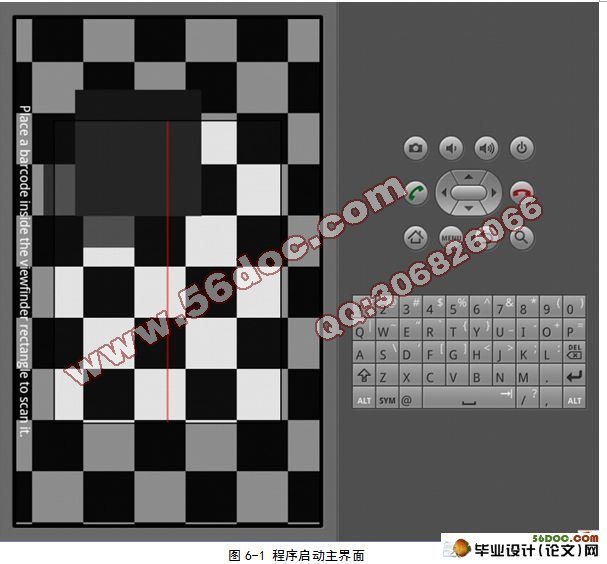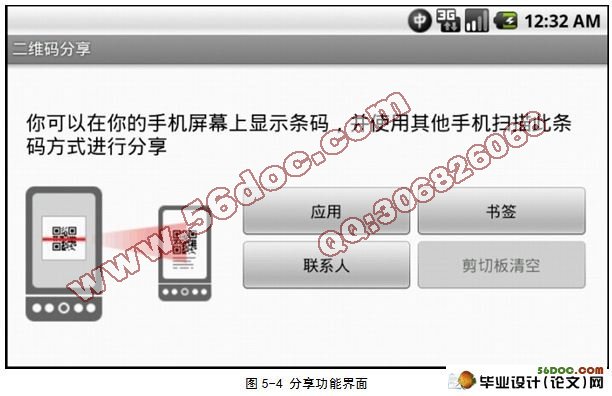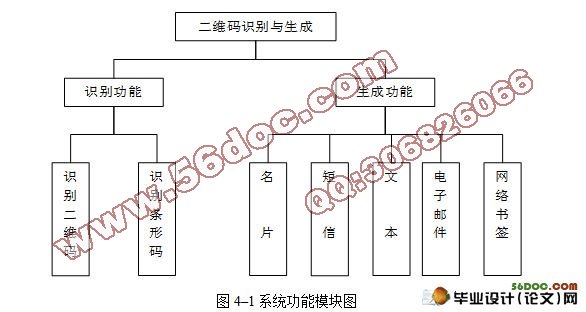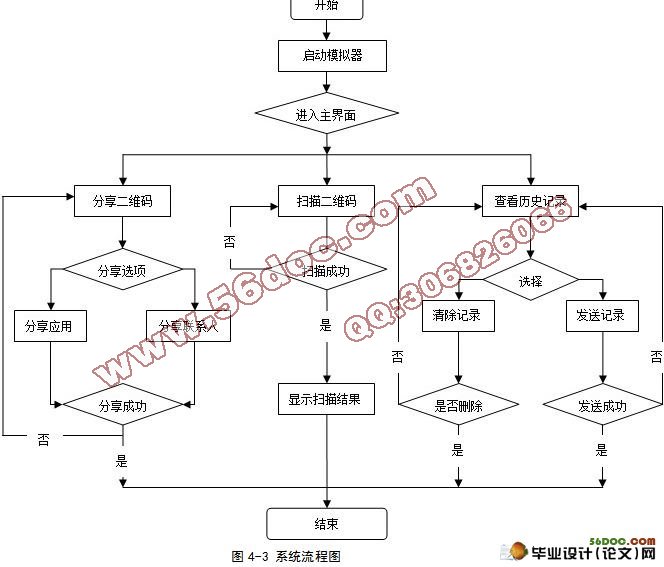基于Android的二维码识别系统的研究与实现
无需注册登录,支付后按照提示操作即可获取该资料.
基于Android的二维码识别系统的研究与实现(含开题报告,毕业论文16000字,程序代码)
[摘 要] 一维条码在生产和生活的各个方面得到了广泛的应用,极大的提高了生产率,但是一维条码本身的缺点:信息量小、依赖数据库等也日益的现露出来。二维条码本身具有高容量、高密度、纠错能力强、安全强度高等特点,使得二维条码作为信息的载体在信息自动化领域发挥着越来越重要的作用。QR码作为快速响应二维码,以其独特的优势,在汉语国家发展迅速。目前,国内QR码的识别大多是基于PC的,而且对于光照不均、背景较复杂的二维码图像,其识别速度和准确度也有待提高。另外,Android平台上当前流行的二维码识别软件普遍存在着扫描速度慢,需要精确对焦等缺点,而且大都是由国外开发。鉴于此,深入研究QRCode码的准确与快速识别算法及其在Android手机平台上的软件实现具有十分重要的意义。本课题分析研究QRCode二维码编解码原理与图像预处理算法,根据Android嵌入式平台的特点,设计出一种嵌入式设备中的QRCode二维码别软件,具有很强的实用性。本文首先分析研究了QR码结构的基本特征、编解码理论、RS纠错算法和二维码图像预处理算法,然后在当前预处理算法的基础上,基于QR码图像的特点,进行程序的编写。课题利用Android平台,设计出一套QR码的识别系统,系统首先在模拟器中运行,然后下载到手机中进行测试。最后论文给出了测试结果。
[关键词] Android;条码;二维码;识别
Research and Implementation of QRcode Recognition System Based on Android
Abstract: One-dimension barcode is widely used recent years in all aspect of life, which greatly improved the productivity. However, the faults of 1-D barcode have become increasingly apparent, the information storage of it is so little, and also it must be rely on database. Two-dimension barcode has the characteristics of high capacity, high density, high security and good error correction ability, which make it play more and more important role in information and automation field. QRCode(Quick Response Code), as a 2-D barcode, develops rapidly in Chinese speaking countries with its unique advantages. At present, in our nation, recognition of QRCode mostly bases on PC, and especially for QR image with uneven illumination or complicated background, the recognition speed and accuracy are not so good. Moreover, the popular barcode recognition software on android platform has some shortcomings prevalently, such as slow speed of recognition, etc. This article studies the QRCode codec theory and barcode image preprocessing algorithms, and then puts forward some optimization algorithms based on embedded android mobile phone system, and designs a QRCode recognition system. At first, this thesis makes a deep research on QRCode features, codec theory, RS error correction algorithm and 2-D barcode image preprocessing algorithms. And then in the current pretreatment algorithm, and on the basis of the characteristics of the QR code based on image, the writing of the program. Then, a QRCode recognition system is implemented on Android platform. This system firstly is tested on emulator and then downloaded on HTC mobile phone. At last, thesis gives the test results.
Key words: Android;Barcode;Two-dimension code;Recognition
本次的毕业设计主要就是在基于Android平台下设计并开发一个条码二维码识别系统。运用当前Google提供的Android SDK来以及开源项目Zxing核心库编码解码原理为基础,来实现二位码识别系统。
本课题的总体的功能业务可以主要描述为以下几点:
(1) 主界面上显示出主要的功能
(2) 进行一维条行码的识别
(3) 进行二维QR码的识别
(4) 进行二维DM矩阵码识别
(5) 对二维码进行分享
(6) 软件使用帮助
3.1.3 课题功能需求分析说明
根据对本课题的主要需求的分析做如下说明:
(1) 主界面上主要就是显示该系统所能够进行的动作和所能实现的功能,也是用户进行软件操作的主要界面。
(2) 本软件最强大的功能是实现当前主流的条码、QR码和DM矩阵码的识别功能。
(3) 可以分享二维码。
(4) 对扫描历史进行查看。
(5) 对软件使用提供帮助。
3.1.4 系统界面需求
本系统的界面需要布局合理、美观,需要体现系统的友好性。
3.1.5 系统性能需求
本系统需要扫描速度快、安全性高、处理结果速度快,尽可能为用户节省时间。
3.1.6 运行环境需求
系统运行环境:基于Android操作系统移动设备
系统支持版本:Android 1.5及以上版本
开发环境:Eclipse 3.5 ADT16-16.0.1 JDK-7u3-windows-i586







目 录
1 Android系统开发背景与意义 1
1.1 Android系统平台的出现 1
1.2 Android系统的发展 1
1.3 Android系统架构的介绍 1
1.4 Android开放系统 3
1.5 Android系统的特点 3
2 二维码识别系统背景介绍 3
2.1 二维码识别系统背景 3
2.1.1 二维码技术产生的背景 3
2.1.2 二维码分类及其特点 4
2.1.3 二维码技术国内外的发展 5
2.2 二维码技术研究的意义和应用 6
2.2.1 二维码技术的应用 6
2.2.2 二维码研究的意义 7
3 需求分析 8
3.1 系统需求分析 8
3.1.1 课题可行性分析 8
3.1.2 课题功能需求分析 9
3.1.3 课题功能需求分析说明 9
3.1.4 系统界面需求 9
3.1.5 系统性能需求 9
3.1.6 运行环境需求 9
3.2 系统需要解决的问题 9
3.3 系统关键技术分析 10
3.4 本章总结 10
4 系统设计 10
4.1 课题需要解决的问题 10
4.1.1 界面布局 10
4.1.2 条形码二维码解码功能 10
4.2 系统总体设计 11
4.2.1 课题功能框架 11
4.2.2 课题总体流程图 12
4.2.3 数据库的概念结构设计 13
4.3 系统详细设计 13
4.3.1 系统模块设计 13
4.3.2 系统界面详细设计 16
4.3.3 数据库详细设计 16
4.4 本章小结 17
5 编码与实现 17
5.1 开发环境搭配 17
5.1.1 软件下载安装 17
5.1.2 配置环境变量 17
5.2 二维码识别系统功能实现 17
5.2.1 二维码识别系统界面设计 17
5.2.2 二维码功能的设计与实现 19
5.2.3 查看扫描历史记录功能实现 21
5.2.4 分享功能实现 22
5.3 本章小结 22
6 系统测试与运行 22
6.1 测试目的 22
6.2 测试环境 23
6.3 测试的流程和测试 23
6.3.1 基于Android模拟器的运行测试 23
6.3.2 基于Android移动设备的运行测试 24
6.4 本章小结 27
结束语 28
参考文献 29
附录 30
致谢 31
